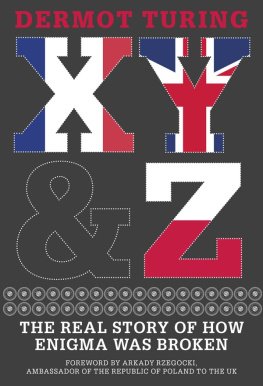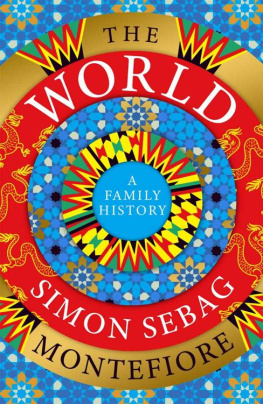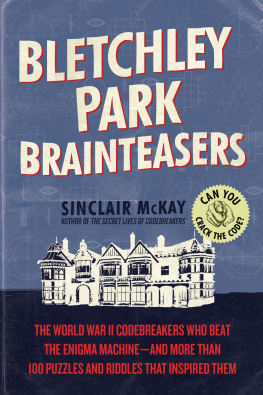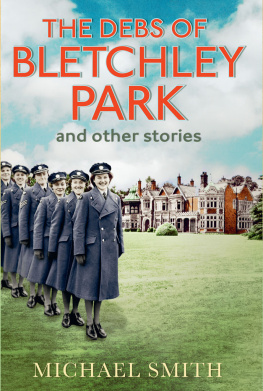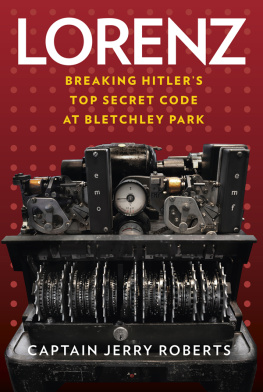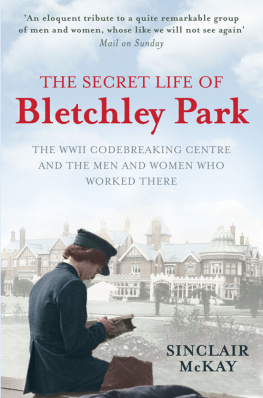ENIGMA
The Battle for the Code

Hugh Sebag-Montefiore

For Aviva Burnstock, my wife, and for Saul and Esther, my children
This book is printed on acid-free paper. 
Copyright 2000 by Hugh Sebag-Montefiore. All rights reserved
Published by John Wiley & Sons, Inc.
First published in Great Britain in 2000 by Weidenfeld & Nicolson
No part of this publication may be reproduced, stored in a retrieval system, or transmitted in any form or by any means, electronic, mechanical, photocopying, recording, scanning, or otherwise, except as permitted under Section 107 or 108 of the 1976 United States Copyright Act, without either the prior written permission of the Publisher, or authorization through payment of the appropriate per-copy fee to the Copyright Clearance Center, 222 Rosewood Drive, Danvers, MA 01923, (978) 750-8400, fax (978) 750-4744. Requests to the Publisher for permission should be addressed to the Permissions Department, John Wiley & Sons, Inc., 605 Third Avenue, New York, NY 10158-0012, (212) 850-6011, fax (212) 850-6008, email: PERMREQ@WILEY.COM. This publication is designed to provide accurate and authoritative information in regard to the subject matter covered. It is sold with the understanding that the publisher is not engaged in rendering professional services. If professional advice or other expert assistance is required, the services of a competent professional person should be sought.
Library of Congress Cataloging-in-Publication Data:
Sebag-Montefiore, Hugh.
Enigma : the battle for the code / Hugh Sebag-Montefiore.
p. cm.
Includes bibliographical references and index.
ISBN 0-471-40738-0 (cloth : alk. paper)
1. Enigma cipher system History. 2. World War, 19391945 Cryptography. I. Title.
D810.C88 S43 2001
940.5485 dc21
00-0439-20
Printed in the United States of America
10 9 8 7 6 5 4 3 2 1
Contents
Belgium and Germany, 1931
Poland, Belgium and Germany, 192938
Poland, 1932
Poland, 19339
Germany, Poland and England, 193940
Scotland, 1940
Norway and Bletchley Park, 1940
France and Bletchley Park, MaySeptember 1940
Bletchley Park, AugustOctober, 1940
Bletchley Park and the Mediterranean, March 1941
Norway, March 1941
North of Iceland, May 1941
The Atlantic, May 1941
North of Iceland, June 1941
Bletchley Park, the Atlantic and Berlin, MayOctober 1941
The Atlantic and the Cape Verde Islands, September 1941
The South Atlantic and Norway, November 1941March 1942
Bletchley Park and Norway, December 1941
The Barents Sea, Bletchley Park and the Admiralty, FebruaryJuly 1942
The Mediterranean and Bletchley Park, OctoberDecember 1942
South of France, the Mediterranean and the Atlantic, November 1942September 1943
South of France, November 1942March 1943
Berlin, MarchSeptember 1943
The Barents Sea, December 1943
Paris, the Indian Ocean and the Atlantic, August 1943March 1944
Germany, France and the South Atlantic, MarchJune 1944
Illustrations
Illustrations follow page 146.
All photographs were printed from originals by Steve Aldridge and Emma Hunt at Sky Photographic Services, London. The picture source is given in brackets.
Acknowledgements
This book would never have been written had it not been for the publication of Robert Harriss novel Enigma, and the West End production, and TV adaptation, of Hugh Whitemores play Breaking The Code. These two dramas, which are both based on what happened at Bletchley Park during the Second World War, not only fascinated me, but popularized the Enigma story, and showed that there was a market for more books on the subject.
Three historians have also been an inspiration: firstly, the late Sir Harry Hinsley, who not only played such an important part in the breaking of the Naval Enigma, but who also masterminded the production of, and co-wrote, the official five volume history British Intelligence in the Second World War. Critics of these volumes complain that they are full of useful facts, but fail to describe the colourful characters who took part in the exciting events described. However Sir Harry more than made up for that when he was interviewed by me, generously holding nothing back for his own private use, even though he was in the process of writing his autobiography. Secondly, I am indebted to David Kahn, whose Seizing The Enigma is the best history book about the Naval Enigma captures to date. He also gave me any help he could when I was searching for Germans who were on captured German ships and U-boats. Thirdly, I would not have been able to find so many previously unpublished sources for this book had it not been for the help of Ralph Erskine, a retired barrister, who has become the leading expert on the Naval Enigma. I am also grateful to Stephen Budiansky whose book Battle of Wits: The Complete Story of Codebreaking in World War II is the most comprehensive account to date in relation to the American role in breaking the Enigma.
The four historians mentioned above only represent the tip of the iceberg. The following historians have been just as generous with their time and expertise: Ralph Bennett, the writer of several books about Ultra, including Behind The Battle, the late Clay Blair, whose two volume Hitlers U-Boat War has raised the standard of dramatic writing in books about U-boats to new heights, Gilbert Bloch, the French expert on Enigma, Alec Douglas, the writer of the official history of the Canadian Navy during the Second World War, Captain Bernard Edwards, an expert on convoy victims, the Polish Enigma experts Jozef Garlinski and Wl-adysl-aw Kozaczuk (the writer of Enigma: How the German Cipher Machine Was Broken, and How It Was Read By the Allies in World War Two). Also, Timothy Mulligan, the archivist and historian who works at the National Archives in Washington, Dr Axel Niestl and Professor Jrgen Rohwer, the German U-boat specialists, Dr Berthold Sander-Nagashima, a historian at the Militrgeschichtliches Forschungsamt, Professor Alberto Santoni, the Italian expert on Enigma intelligence, Roger Sarty, Director of Historical Research at the Canadian War Museum, Hugh Skillen, the organiser of Enigma Symposiums, Professor Jean Stengers, an expert on the French and Polish contributions in the Enigma story, Alan Stripp, one of Sir Harry Hinsleys co-editors of Codebreakers, the first book in which a collection of cryptographers explained how the Enigma code was broken, and Dr Yves Tremblay and Jean Morin, from the Directorate of History and Heritage, National Defence, in Canada. Professor Colin Burke, the first historian to describe in detail the American contribution to the breaking of the Enigma code, which he did in his book Information and Secrecy, and Stephen Budiansky, the writer of Battle of Wits: The Complete Story of Codebreaking in World War II, also kindly made available or explained some of their best source material relating to the US and Enigma.
I am equally indebted to the following historians, librarians and editors who assisted me or have permitted me to use their collections: Professor Andrzej Ajnenkiel of Wojskowy Instytut Historyczny, Warsaw, Axel Betten and Stefan Khmayer of Deutsche Dienstelle Wehrmacht Auskunft Stelle, Berlin, Margaret Bidmead of the Royal Navy Submarine Museum, Gosport, David Brown and Jock Gardiner, historians, Kate Tildesley and Bob Coppock, foreign document curators, and Jenny Rate, Admiralty Librarian at the Naval Historical Branch of the Ministry of Defence, Helmut Dringhoff of Bundesarchiv Militrarchiv in Freiburg, Germany, Michael Gray, an editor at Navy News, Jenny Hill at the National Maritime Museum, Greenwich, Volker Hogrebe of Verbandzeitschaft des Deutschen Marinebundes, Grzegorz Kowalski of Centralne Archiwum Wojskowe, in Poland, Christine Lecuyer at the Department of Veterans Affairs, Canada, David Prior at the House of Lords Record Office, Hans-Jrgen Schneider of Verband Deutscher U-Bootfahrer, Claire Sibille of the Service Historique de lArme de Terre at the Ministre de la Dfense in France, Andrzej Suchcitz at the Polish Institute and Sikorski Museum in London, John Taylor and William Cunliffe at the National Archives in Washington. The assistance Horst Bredow gave me at the U-boat Archive at Altenbruch, near Cuxhaven in Germany, and which Graham Smith gave me at the Naval Manning Agency in Portsmouth, deserve a special mention; without their help it would have been impossible to have discovered so much about what happened on board the U-boats which were captured along with their Enigma codebooks, and aboard the British ships which captured them.



